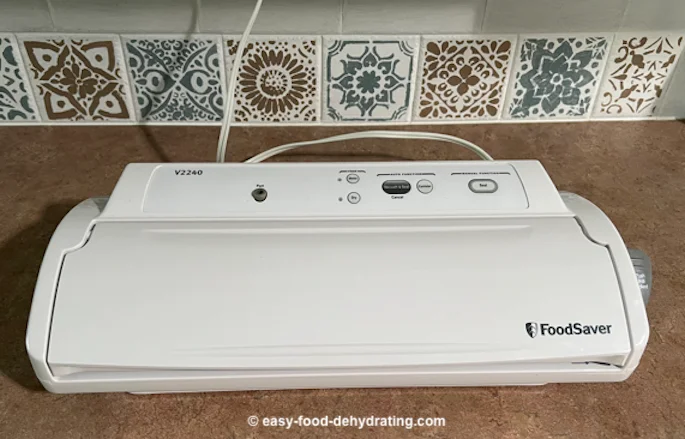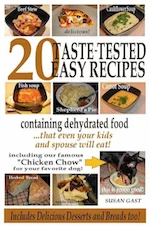- Home
- Articles On How To Dehydrate Food Safely
- Does Dehydrating Food Destroy Nutrients?
Does Dehydrating Food Destroy Nutrients?
Get the Facts First

Susan Gast | Author and blogger at Bored Boomers, Beesville Books, A New Sober You and Easy Food Dehydrating
Does Dehydrating Food Destroy Nutrients? Here’s What You Need to Know
Does dehydrating food destroy nutrients? It’s a great question.
According to this post from the University of Missouri, Vitamins A and C can be destroyed by heat and air when dehydrating food.

But let's not forget this: heating food by baking, boiling, broiling, and grilling ALSO destroys nutrients! Only by eating raw fruits and vegetables do we get to enjoy their full nutritional value.
Are You Losing Vital Nutrients When You Dehydrate Food?
Yep. The loss of Vitamins A and C through heat and air is a bit of a bummer because using heat and air is the primary way of dehydrating food!
This vitamin loss is easily rectified by taking a daily vitamin supplement.
But Wait—Some Nutrients Can Be Saved With This One Tweak
But… the lower the temperature you dry vegetables at, the more nutrients they retain. That makes sense, right?
Fruits and vegetables are dehydrated between 125°F and 135°F (or per your food dehydrator's instructions).
My one exception is Mushrooms. They are dehydrated at 90°F for Excalibur dehydrators, and 95°F for Nesco dehydrators - for two to three hours THEN set the temperature to 125°F and dry for the remaining time.
💡 Tip: Use our Fahrenheit to Celsius converter here on our site!
The Surprising Prep Step That Can Drain Your Nutrients
When dehydrating certain vegetables, we need to blanch them. Read how and why here.
Blanching will also result in a loss of Vitamin C, B-Complex—and water-soluble minerals. Again, taking a daily vitamin supplement will more than make up for the vitamin and mineral loss.

For those of us who are rightly concerned with our sugar intake, please bear in mind that dehydrating fruit (that are high in natural sugars) will result in an even higher sugar concentration after dehydrating!
Why is that? Keep reading!
Why Dehydrated Fruit Packs a Sugar Punch
When you remove the water from sugar-laden foods, you're left with an even more condensed version of that food, sugar-wise. Read our post on The Pros and Cons of Dried Fruit which goes into details of dried fruit and its sugar content.
When we dehydrate food, we remove the water that’s inside our fruits (and vegetables) in an attempt to kill micro-organisms so the food won’t spoil as quickly (like they do when fresh). In an effort to also combat food spoilage, we use oxygen absorbers.
How to Lock in Freshness After Dehydration
Oxygen Absorbers at Amazon
NOTE:
50cc are perfect for small jars and containers. Ideal for keeping spices and smaller dried foods fresh.
100cc are great for quart-sized jars and vacuum-sealer bags. The most versatile size for everyday use.
- PackFreshUSA Oxygen Absorbers
- 200-Pack
- Food-Grade, Non-Toxic
- Oxy-Sorb Oxygen Absorbers
- 100-Pack
- Long-Term Food Storage Freshness Protection
- Oxy-Sorb Oxygen Absorbers
- Bags of 20 (60 Count total)
- Super Effective for Dried Goods
- Oxy-Sorb Oxygen Absorbers
- Pack of 10
- I use these for airtight bins and buckets
As an Amazon Associate, I earn commission from qualifying purchases. The price you pay does not increase. Read disclosure here.
The job of an oxygen absorber is to inhibit mold growth.
After our foods have been dehydrated—they are ready to be vacuum-sealed and then stored in Mason jars (shown below) or in food vacuum-sealer bags for daily use or long-term storage.
Mason Jars Are Your Best Friend for Storage
Mason Jars at Amazon
Mason Jars Regular Mouth Quart Jars
- Ball brand regular mouth Glass Mason Jars. Quart size (32oz)
- Package of 12
Mason Jars Wide Mouth Pint Jars
- Ball brand wide mouth Glass Mason Jars. Pint size (16oz)
- Package of 12
Mason Jars Wide Mouth Half Pint Jars
- Ball brand wide mouth Glass Mason Jars. Half-Pint (8oz)
- Package of 12
As an Amazon Associate, I earn commission from qualifying purchases. The price you pay does not increase. Read disclosure here.
Here's What Happens to Sugar in Fruit After Dehydration
Let's get back to the sugar content in fruit: What we are left with after dehydrating is the fruit minus water. Fruit shrinks.
So what? you’re thinking...
When our fruit shrinks after dehydrating, it means there’s a strong chance that we’ll want to eat more of it (due to it being smaller)—and that’s where portion control for dried fruit especially—has to come into play.
Now then, if only dehydration would take out the sugar too, we’d all be a lot healthier.
Stocking Up Smart: What You Need Before Shelves Go Empty
Don’t allow the above information regarding the loss of some vitamins to deter you from dehydrating food. What we are trying to achieve is having enough food in your pantry.
When the “stuff” hits the fan, there’s nothing worse than rushing out to your grocery store to stock up, only to be greeted by empty shelves. Get ahead of the game by keeping your food pantry full, whatever the reason or season (as my website slogan says).
Did you know, when natural disasters hit (earthquakes, hurricanes, etc.) the average family has only enough food in their refrigerator and pantry to last for 3 days... that's only nine meals? Don't let this happen to your family.
New to Dehydrating? Grab This Must-Have Free Guide
Get our free eBook and learn the quick Six Simple Steps on how to safely dehydrate fresh fruits 'n' veggies (and cooked meats). Not only that, you need to know how to safely store it too!
Opt-in today by clicking the red "Six Simple Steps" link above. The free eBook covers the six necessary steps you need to know to dehydrate food safely at home.
Bonus Freebie! Get Our Herb Drying Guide Before You Go
While you're picking up the Six Simple Steps freebie, why not pick up a free copy of our "How to Grow and Dehydrate Herbs" too? Just click the link to visit the download page.
You'll learn how to dehydrate the top six popular herbs
- basil
- oregano
- thyme
- rosemary
- sage
- lavender
and how to make herb-infused oils,
too. Perfect for gift-giving!
Thanks for stopping by "Does dehydrating food destroy nutrients." I hope I answered your question about the possibility of nutrients being destroyed by the dehydration process.
If you have any questions at all, feel free to drop me an email here. I'll get back to you pronto!
Before You Go...
If you like the content, please give me some love by clicking on the 🩷 in the lower right hand corner (on just about all my pages). This signals to me that you find it enjoyable and useful. Thank you so much!

























